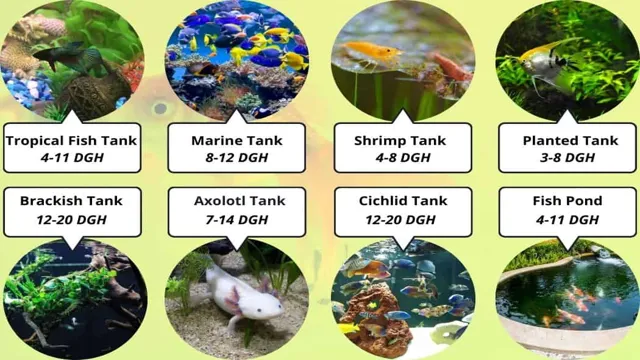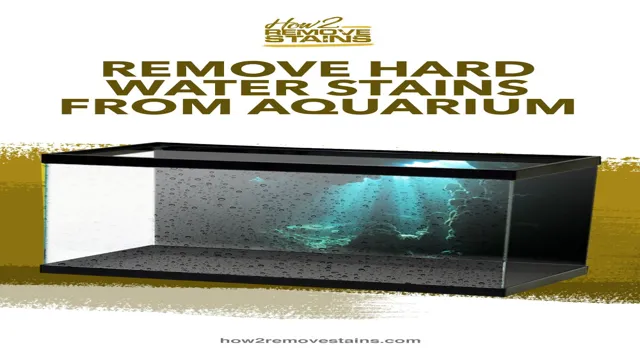If you’re a fish keeper, you know that maintaining a proper water hardness level in your aquarium is crucial for the health and well-being of your aquatic pets. But sometimes, due to the type of water available in your area, you may find yourself dealing with hard water that can cause many issues with your tank’s inhabitants. In this comprehensive guide, we’re going to tackle all aspects of lowering aquarium water hardness, from what it means and why it’s essential, to step-by-step procedures for bringing hardness levels down and maintaining them.
So buckle up and get ready to learn how to give your delicate pets the best living environment they deserve without stressing yourself or them out!
Understanding Water Hardness
Knowing how to lower aquarium water hardness is crucial for any aquarium owner. But first, it’s important to understand what water hardness is. Water hardness is a measure of dissolved minerals such as calcium and magnesium in the water.
High levels of water hardness can harm your fish, plants, and even the equipment in your aquarium. There are a few ways to lower water hardness, one of which is adding peat moss to your aquarium. Peat moss is very effective in softening water and lowering hardness because it contains organic acids that bind with minerals in the water.
It’s also important to regularly change your aquarium water and use a water conditioner that removes minerals, to maintain a balanced and healthy environment for your aquatic pets. By understanding water hardness and taking proactive measures to keep it in check, you can ensure your aquarium thrives.
What is water hardness?
Water hardness refers to the concentration of minerals, specifically calcium and magnesium, in water. Hard water often results in a film or scale buildup on fixtures and appliances, decreasing their efficiency and lifespan. The hardness of water is typically measured in grains per gallon or parts per million.
While hard water may not pose a health risk, it can be a nuisance for those who want to maintain shiny and clean surfaces in their homes. Water softeners are commonly used to remove excess minerals and reduce water hardness. By understanding the concept of water hardness and its impact on daily life, you can make informed decisions on how to treat your water and keep your home running smoothly.

Why is water hardness important for aquariums?
Water hardness is an essential factor to consider when maintaining an aquarium. Hardness refers to the concentration of dissolved minerals, particularly calcium and magnesium ions, in the water. The hardness levels of aquarium water can impact the health and well-being of aquatic life.
High levels of hardness can lead to the accumulation of toxins and negatively impact the growth and reproduction of fish and plants. On the other hand, low hardness levels can make it difficult for small aquarium animals to maintain proper bodily functions. Therefore, it’s crucial to maintain optimal water hardness levels through regular testing and water changes.
By doing so, we can create a healthy and thriving underwater ecosystem. So, always monitor the water hardness levels of your aquarium and make adjustments accordingly to ensure an ideal environment for your aquatic pets to live in.
What are the different types of water hardness?
Water hardness refers to the level of minerals, mainly magnesium and calcium, present in the water. It usually occurs when rainwater seeps through the soil or travels over underground rocks that contain these minerals. There are two types of water hardness: temporary and permanent.
Temporary hardness is caused by the presence of dissolved bicarbonate minerals such as calcium bicarbonate and magnesium bicarbonate. It can be removed by boiling the water, which causes the minerals to precipitate out of the solution. This type of hardness is often found in areas with limestone or chalk aquifers.
Permanent hardness is caused by the presence of dissolved sulfate and chloride minerals, such as calcium sulfate and magnesium chloride. Unlike temporary hardness, permanent hardness cannot be removed by boiling the water. Areas with volcanic or igneous rocks typically have this type of hardness.
It is essential to determine the type of hardness in your water to select the appropriate method for treatment. Temporary hardness can be easily removed by boiling, but permanent hardness requires a water softener that uses ion exchange resin to remove the minerals. Understanding the different types of water hardness can help you make informed decisions about water treatment and prevent any damage caused by hard water.
Measuring Water Hardness
If you’re an aquarium owner, it’s important to measure your water hardness regularly to keep your fish healthy and happy. Using a test kit, you can determine the levels of calcium and magnesium in your water, which are the two main minerals that contribute to hardness. Soft water is typically less than 75 ppm, while hard water can be over 200 ppm.
If your levels are too high, you may notice cloudy water or your fish may be more prone to disease. To lower aquarium water hardness, you can try adding some driftwood or peat moss to your tank, as they have tannins that can help soften the water. You can also use a water softener resin or an ion exchange system to remove the minerals causing the hardness. (See Also: How to Keep an Aquarium Air Stone Down: Tips and Tricks to Keep Your Fish Tank Running Smoothly)
It’s important to make gradual changes to avoid shocking your fish and to monitor your levels regularly to maintain a healthy environment.
How to measure water hardness
Water hardness is a common issue that arises due to the presence of minerals like calcium and magnesium in the water. Measuring water hardness is essential to determine the level of these minerals in the water, which can affect the quality of the water for everyday use or industrial processes. One common method of measuring water hardness is through the use of test strips or a testing kit.
These kits typically use a colorimetric scale to determine the level of hardness in the water. Another method is by using an electronic water hardness tester, which measures the electrical conductivity in the water. In either case, it is important to understand what level of hardness is ideal for your specific needs and to take measures to soften the water if necessary.
Overall, measuring water hardness is crucial to ensuring that the water you use is safe and of good quality.
Interpreting water hardness test results
Measuring water hardness is an important task as it can impact the quality of your water supply and home appliances. Generally, water hardness is a measure of the amount of dissolved minerals, such as calcium and magnesium, that are present in your water. To measure water hardness, it is best to conduct a water hardness test which will give you a numerical value in parts per million (ppm) or grains per gallon (gpg).
The result of the test will determine the level of hardness in your water. If your water has a hardness level of less than 60ppm or 5 gpg, it is considered soft, while a hardness level of 60-120ppm or
5-7 gpg indicates moderately hard water. If the hardness level is between 120-180ppm or 7-5 gpg, it is hard water, and anything above 180ppm or
5 gpg is considered very hard water. Knowing your water’s hardness level can help you figure out the best methods to soften or treat it to improve its taste and prevent damage to your appliances.
How often should you test your water hardness?
Water hardness is a common issue for homeowners across the globe. If you are one of them, it is essential to measure your water hardness frequently to ensure the water you use for various purposes is safe and healthy. So, how often should you test your water hardness? We recommend that you test your water hardness at least once a year, and more often if you notice changes in water quality.
Typically, water hardness varies based on the natural mineral content in your area’s water source. Factors such as the time of year and human-made contamination can also contribute to variations in water hardness. To ensure peace of mind and the safety of your household, it is best to have a water hardness test kit on hand and to check your water hardness regularly.
Methods for Lowering Water Hardness
If you’re struggling with water hardness in your fish tank and wondering how to lower aquarium water hardness, there are several methods you can try. One option is to use Reverse Osmosis (RO) water or filtered tap water to reduce the hardness. Another method is to use chemical additives such as aquarium salt or water conditioners designed to soften the water.
Driftwood or peat moss can also lower the water hardness over time but this method is more slow-acting. It’s important to regularly test the water hardness levels to ensure that the methods you’re using are effective and not causing any harm to your fish. With a little patience and experimentation, you should be able to find the method that works best for your aquarium.
Method 1: Dilution with distilled or RO water
One way to lower water hardness is to dilute it with distilled or reverse osmosis (RO) water. Hard water contains high levels of minerals, such as calcium and magnesium, which can leave buildup in pipes and appliances and make it difficult to lather soap or shampoo. Diluting hard water can help reduce these effects.
Distilled water is free of any minerals, making it ideal for dilution. RO water is also low in minerals, but it may still contain some trace elements. To dilute with distilled or RO water, simply mix the two together in a ratio that works best for your needs.
Keep in mind that diluting water can make it more acidic, so it’s important to monitor the pH level and adjust as necessary. Diluting with distilled or RO water can be an effective and affordable way to make hard water more manageable. (See Also: How to Clear Water Aquarium: 7 Easy Steps for Crystal Clear Tank)
Method 2: Use of a water softener pillow or resin
Using a water softener pillow or resin is another effective method of lowering water hardness. These items work by attracting and trapping the hard water minerals such as calcium and magnesium. A water softener pillow is simply a cloth pouch filled with a softening compound.
It can be suspended in the water source such as a fish tank or aquarium, where it begins to release the softening agents. Water softener resin, on the other hand, is typically used in water softening systems that are installed throughout a home or building. Resin tanks contain millions of small resin beads that work to remove hard water minerals from the water before it enters the piping system.
Both options are effective in removing hardness from water, but using a water softener system is far more efficient and effective for larger water sources. If you’re struggling with hard water, consider using a water softener pillow or resin to alleviate the issue.
Method 3: Use of chemical additives
If the other two methods for lowering water hardness aren’t working out for you, adding chemical additives is a common solution. This method uses a process of ion exchange to replace the hard minerals in the water with softer ones. Chemical additives can help to prevent the buildup of limescale and other mineral deposits in your pipes and appliances.
One of the most commonly used chemical additives is sodium hexametaphosphate, which is added to water as it enters the home. This compound binds to the calcium and magnesium ions in the water, preventing them from forming limescale deposits. Although chemical additives can be effective, they also come with their own set of drawbacks.
Overuse of these additives can lead to water quality issues, and they can be harmful to the environment. It’s crucial to use chemical additives in moderation and under the guidance of a professional plumber to avoid any negative effects.
Factors to Consider Before Lowering Water Hardness
If you are a fish tank enthusiast, you must be aware of the importance of water hardness for the survival of aquatic plants and animals. While high water hardness can cause harm to your aquatic friends, extremely low levels can also pose a threat. Thus, before you start lowering the water hardness of your aquarium, you need to consider a few factors.
Firstly, check the current water hardness using a testing kit to ensure it is within the optimal range for your aquarium’s inhabitants. Secondly, check the types of fish, plants, or marine animals in your aquarium as some require higher hardness levels than others. Thirdly, take your time and decrease the water hardness gradually to prevent sudden fluctuations that may harm aquatic life.
Lastly, ensure that the pH level of your aquarium remains stable during the process. Knowing how to lower aquarium water hardness can tremendously benefit your aquarium ecosystem; however, it is essential to take precautions to prevent harming your aquatic friends.
Type of fish and plants in your aquarium
If you’re thinking about lowering the water hardness in your aquarium, there are a few factors to consider before taking action. One important thing to keep in mind is the type of fish and plants you have in your tank. Some species, like African cichlids, require harder water to thrive, while others, like certain tetras and bettas, prefer softer water.
Additionally, the plants in your aquarium may also have specific water hardness requirements for growth and health. Another factor to consider is the pH level of your water, as this can also affect the health of your fish and plants. It’s important to do your research and make gradual changes to your water hardness to avoid shocking your aquatic creatures.
By taking these factors into consideration, you can create a healthy and comfortable environment for your fish and plants to thrive in.
Current pH levels and temperature of your aquarium
When it comes to maintaining a healthy aquarium, it’s essential to keep an eye on the pH levels and temperature of the water. Before you think about lowering the water hardness, there are a few factors to consider. Firstly, the current pH levels.
If your water is already on the acidic side, it’s best not to lower the hardness further as it can cause an imbalance and harm your fish. Similarly, if the temperature is too high, it’s not an ideal time to tamper with the water hardness. It’s crucial to ensure the conditions are stable before making any changes.
It’s also worth noting that some fish species, such as African cichlids, require hard water to thrive, so lowering the hardness may not be necessary or even harmful. Always do your research and consult with a professional before altering the water’s hardness. Remember, a healthy aquarium is a delicate balance, and any sudden changes can have adverse effects on your fish’s health and well-being. (See Also: How to Maintain Aquarium Snails: Easy and Effective Tips for Healthy Tank Inhabitants)
The source of your aquarium water
Aquarium Water, Lowering Water Hardness When it comes to maintaining a healthy aquarium, the source of your water can have a significant impact. Ideally, you want to start with water that is free from contaminants and pollutants. This can be achieved by using a high-quality water filter or purchasing distilled water from a trusted source.
In addition to the quality of your water, you also need to consider its hardness. Water hardness refers to the amount of dissolved minerals present, such as calcium and magnesium. While some aquarium fish thrive in hard water, others require softer water to survive and thrive.
Before lowering your water hardness, it’s important to consider the needs of your specific fish species and the plants in your aquarium. You can use a water hardness test kit to determine the level of hardness in your water and make adjustments accordingly. In doing so, you can create the ideal environment for your aquatic pets and ensure their long-term health and happiness.
Conclusion
In conclusion, lowering aquarium water hardness requires a bit of science, a sprinkle of dedication, and a pinch of creativity. Whether you decide to use reverse osmosis, add peat moss, or strategically choose low-hardness rocks, there are plenty of ways to get your water in tip-top shape for your aquatic friends. Just remember to test your water regularly and never underestimate the power of research and experimentation.
With a little bit of effort, you’ll have your fish swimming blithely in their pristine, softened home in no time!”
FAQs
What causes high water hardness in aquariums?
High water hardness in aquariums is usually caused by dissolved minerals in the water such as calcium and magnesium.
Why is it important to lower aquarium water hardness?
High water hardness can be harmful to fish and other aquatic life, causing stress and impacting their overall health.
What are some effective ways to lower aquarium water hardness?
Adding peat moss, driftwood, or using a water softener can help lower water hardness in your aquarium.
How often should you measure water hardness in your aquarium?
It’s recommended to measure water hardness in your aquarium at least once a month to track any changes in levels.
Can high water hardness be harmful to aquarium plants?
Yes, high water hardness can negatively impact the growth and health of aquarium plants by limiting nutrient uptake.
Is it safe to use chemical water softeners in aquariums?
Some chemical water softeners can be safe for aquarium use, but it’s important to carefully research and choose a product that is specifically designed for aquariums.
How long does it take for water hardness levels to decrease?
The length of time it takes for water hardness levels to decrease will depend on the specific method used to lower it and the hardness level of the water to begin with. It may take several weeks to see noticeable changes.







